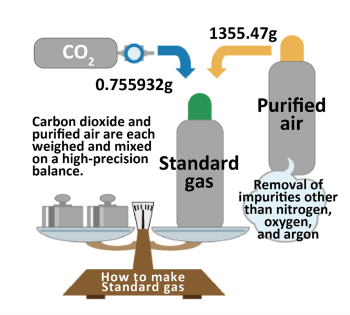Management and development of standard gases
In recent years, measuring devices that display the concentration of carbon dioxide in the atmosphere have become familiar to us, for example, to see the degree of ventilation in a room. However, the values these devices display are very rough, and even when the same type of device is used side by side, they often show different values. The analyzers used in the research are much more accurate (and expensive), but even so, since carbon dioxide, which is about 0.04% of the atmosphere, increases or decreases on the order of two orders of magnitude further down, several innovations are needed to study it.
One of them is to use an accurate measure besides the measuring instrument. The measure for gas measurement is a gas (standard gas) in which the concentrations of the constituents are precisely known.
Unique high-precision standard gases
We use our own standard gases for greenhouse gas observations. The NIES scale is a measure (scale) of the National Institute for Environmental Studies (NIES). Since observing atmospheric GHGs requires accurately capturing slight variations over time, it is essential to have an accurate standard that does not change. However, it is sometimes difficult to determine from our standard gas alone that there is no change, so we compare each other's scales with those of institutions conducting similar observations in Japan and overseas to check for any changes in their relationships.
Figure 1 shows the difference between the NIES scale (09 scale) and the WMO scale (X2007) from the results of the high-pressure gas cylinder Round Robin comparison experiment sponsored by the World Meteorological Organization (WMO). This shows that both scales are in agreement within 0.1 ppm. However, we realize that the WMO scale was revised in 2021, and the difference between the two has changed. We continue to compare each other, including our long-term relations.

Types of Standard Gases

- Primary Standard gas
- It is the most standard gas, as in a kilogram standard. Cylinders (high-pressure gas cylinders) are filled with pure carbon dioxide and purified air in sequence, and each mass is precisely measured using a high-precision balance. The carbon dioxide concentration of the standard gas is determined from the measured mass of carbon dioxide and air. NIES created standard gases with different concentrations from 250 ppm to 530 ppm, as shown in the image. The 10 standard gases valued based on these standards and confirmed to have no (very small) concentration changes in the container are used as the primary standard gases. (NIES 09 scale).
- Secondary Standard gas
- Primary standard gases are prepared in small cylinders because their mass is measured precisely with a balance. Since it is used as a standard for observation over a long period, it cannot be consumed in large quantities. Therefore, a large standard gas cylinder is prepared by precisely calibrating (analyzing) based on the primary standard gases, which are then used as the secondary standard gas. In other words, it is a copy of the primary standard gas.
- Standard gas for on-site observation
- Various concentrations and volumes are made to match the observation. These on-site standard gases are used for observations by aircraft, on the ground, and vessels. The standard gas for on-site observation is a simplified gas calibrated based on the secondary standard gases to obtain an accurate concentration. It is then transported to the observation site.

